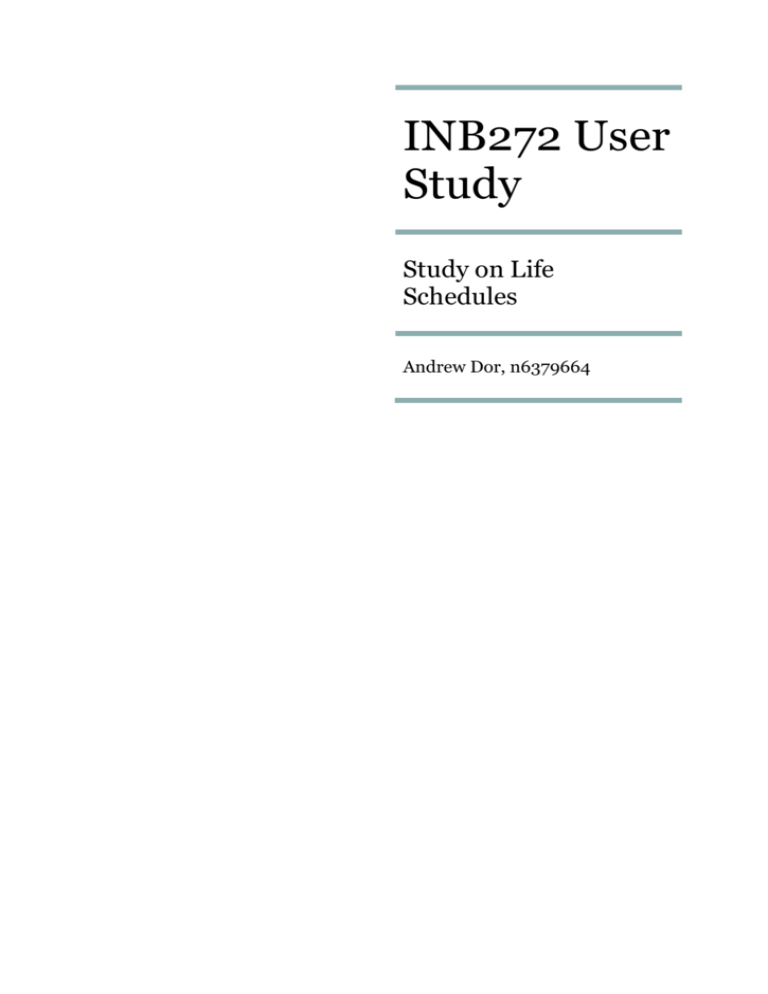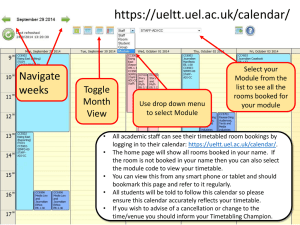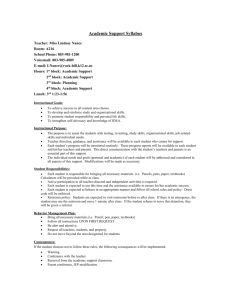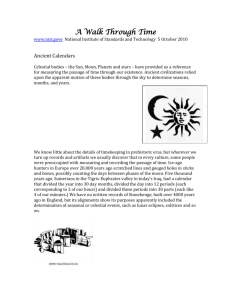INB272ass1 54KB Aug 27 2009 08:53:58 PM - home
advertisement

INB272 User Study Study on Life Schedules Andrew Dor, n6379664 Table of Contents Executive Summary ................................................................................................................... 1 Ethnographic Study ................................................................................................................... 2 Approach Taken ..................................................................................................................... 2 Setting .................................................................................................................................... 2 Data Gathered ........................................................................................................................ 2 Findings.................................................................................................................................. 3 Difficulties and Next Steps ..................................................................................................... 3 Conclusion ................................................................................................................................. 4 INB272 User Study 1 Executive Summary In the study conducted, I observed and analysed the home scheduling life of a typical suburban family consisting of a single mother and her two, identical twin daughters. The study is conducted during the afternoons of two busy days, and the subjects were informally interviewed after the second day. The family generally scheduled well, having a system that involves scrap paper for notation, a physical wall calendar and calendars with reminders in each participant’s mobile phone. Each member also has their own way of scheduling and remembering tasks, but the often involved the mother and the physical act of writing tasks down on the calendar hung in the kitchen. A suggestion for this household would be a digital scheduling system which allows them to share tasks, and sends reminders automatically, however this would be hard to implement as the family is not used to online calendars. Andrew Dor, n6379664 INB272 User Study Ethnographic Study 2 Approach Taken The approach I chose to take was a simple one. I observed the family over during one of the most active times in the house (3pm – 4pm) and then conducted informal interviews with all three members of the household. The usual activities undertaken were observed for approximately an hour on two separate days, and notes were taken by hand about the observations. The focus of the study was to observe and document how each of the members of the household schedule tasks, both individually and communally, and the systems that they use for information management amongst themselves. Each member was asked to explain to me the system that they use to both schedule and remember tasks, and any issues that they knew about or could imagine would happen using their current scheduling system. Setting The household I chose to study consisted of three individuals. A single mother who is the head of the household, and her two daughters who are identical twins aged 16. The main living area where the study was conducted includes two computers, both of which are connected to the internet and in almost constant use during the time studied, a television which is on, and watched by the other family member not on a computer, and the kitchen door, on which the calendar is affixed. Each member of the family has a late model mobile phone, two with touch screens, and all with calendars. All three participants also have laptops, which are used in the bedroom or on the lounge while watching TV. The house has a wireless network which allows them to access the internet from anywhere. Data Gathered The household’s main method of recording schedules and tasks involves a calendar on the wall in the kitchen, and each person the task involves entering the information into their phone calendar, and adding an alarm. During the course of the fieldwork seven tasks were recorded and scheduled, three were for the mother, one was for the youngest sister, and the other three included all three members of the family. Each of the tasks was arranged by phone except one, which came by email. The mother was contacted for six of the seven tasks, and while she was on the phone, she notated the task onto some scrap paper at the computer desk where she was sitting. After writing the task down and completing the phone call, she immediately transcribed the appointments onto the calendar in the kitchen. This was not so with the phone calendar. During the time I was observing, only two of those tasks were added into the mother’s phone instantly after the appointment was created. The last task was for the youngest sister. She received a phone call, and did not notate the task while on the phone. After hanging up the phone, she spent the next 5 minutes finishing what she was doing on the computer, then went and informed her mother of the Andrew Dor, n6379664 INB272 User Study appointment which was then notated onto the calendar in the kitchen. This task only involved the youngest sister, but it was written onto the calendar, and the mother would remind the sister of her appointment. When the mother was informed of a task which involved both the children, she would instantly write the task onto the calendar and then inform them verbally of the task, with the expectation that they would add it into their own personal phone calendars. This however only happened a few times, as the daughters were doing something else and forgot. Findings Of the three inhabitants, it is clear that the mother is the main task scheduler, arranging tasks for both her daughters and herself. Keeping these tasks up to date and written down on the physical calendar in the kitchen allows for easier communication of schedules between all occupants. A flaw in this system is that only the mother checks the calendar regularly (in the mornings and afternoons) and then has to remind the daughters of all events occurring. Although the entire household is very in touch with technology, and uses a computer or smart-phone every day, none of the participants have an online calendar or scheduling system. The mother is the main scheduler in the household, and is involved in most appointments. She uses scrap paper extensively and also annotated everything onto the calendar. She uses her phone extensively to remind herself of appointments an hour in advance. The youngest daughter has a very lax attitude towards scheduling, and does not write down or tell anyone about her personal schedule items. While she says that she does not forget an item, everyone is human. The eldest daughter is a bit more serious, writing items down on scrap paper or the calendar, and telling her mother to remind her, who then writes it onto the calendar to remind herself. Difficulties and Next Steps While conducting the fieldwork and interviews, I believe my presence was interfering with the usual flow of information, and due to my presence each person in the household had a reminder to continue the flow of information, and this slanted my research toward the positive. To eliminate that as a factor, a more extensive study should be undertaken, possibly using hidden recording devices to keep the participants acting naturally. The next steps in this study would involve deeper analysis and possibly observing another family in a similar environment, then compare them with each other, and offer suggestions from one to the other. Andrew Dor, n6379664 3 INB272 User Study Conclusion Through this study I have found that although the household works very well together, and very rarely to never miss appointments, a lot of information is communicated verbally. If a new system were to be designed to improve the lives of the household, it should allow them to schedule items online, and have a shared scheduling and reminder system, but also a personal side. As all users have a mobile phone, SMS reminders could be used to help them remember schedules and appointments. The household spends a lot of time on the internet whether it is on computers, notebooks or internet-enabled mobile phones so the system should definitely be able to be controlled through all aforementioned systems. Possible existing systems include Google Calendar or any other online calendar system. This could be improved by adding functionality specific to these users’ needs. A simple online form connected to the calendar would enable the adding of events quicker and easier for the mother, who is not technically savvy, and a weekly calendar could be emailed each morning, or texted to her phone. Andrew Dor, n6379664 4







